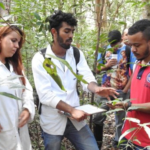
Anne-Maria Korhonen & Satu Aarnio
Collaboration in teacher teams is often successful when teachers design new courses and training programs for students. This work can also be done more systematically, and there are some methods that support collaboration in designing learning processes. One of these is Gilly Salmon’s (2020) Carpe Diem method. In addition, it is sometimes considered how best to evaluate teachers’ work in educational settings. This article describes how Bono’s (1990) Six Thinking Hats method was used to evaluate teachers’ collaborative work in a project where designing learning was a central activity. Both frameworks are presented later in this article, together with the project evaluation results.
HAMK coordinated the Erasmus+ project “Individualised and collaborative and blended learning environment”. The project focused on developing vocational teachers’ pedagogical and digital competences and the learning process was carried out through face-to-face and online workshops. The key element was to create teacher teams who designed learning processes, which was facilitated by following Gilly Salmon’s (2020) Carpe Diem method. This presented small-scale study aimed to explore how the participants found the process of designing learning in teacher teams. In addition, the project process was evaluated.
The evaluation concludes that the Six Thinking Hats method works as an informal and creative method for evaluating collaborative work and that the Carpe Diem method requires quite a lot of facilitation to achieve participation in the designing process.
Carpe Diem and the Six Thinking Hats methods
There are several activating models for designing pedagogical processes in teacher teams. One of them is Gilly Salmon’s (2020) Carpe Diem method. The method is carried out in the following six phases.
- A blueprint explains, among other things, what the learning objectives are, why it is important to study the course being designed, and what the mission and vision of the course are.
- A storyboard is used to design a learning process for the students by following a pedagogical method step by step, also considering the best learning environments and how to connect them. The storyline is a key element in Carpe Diem.
- A prototype will be built in a digital learning environment following the storyline.
- A reality check is carried out by colleagues to give feedback and new ideas for the process.
- A review is made, and the process is edited according to the feedback and the designer’s observations. Finally,
- It is important to plan the next steps with colleagues and make an action plan for the learning design. (Salmon, 2020)
Creative methods such as the Six Thinking Hats can be used to analyse the above process of designing learning in teacher teams. In 1985, psychologist Edward de Bono (1990) developed an alternative way of thinking that he called lateral thinking. Lateral thinking aims to break logical or linear thinking by introducing new perspectives and ways of thinking. The six thinking hats allow logical thinking to be broken down into parts to find new perspectives. De Bono (1996) states that thinking is needed to make plans, solve problems, open up opportunities, take initiatives and design the way forward. The purpose of the Six Thinking Hats method is to break down thinking so that the thinker only uses one way of thinking at a time. The Six Thinking Hats method avoids debate and provides a controlled approach to the topic under discussion.
The Six Thinking Hats are described in six different colours, each with a specific meaning for approaching the topic. The white hat introduces facts and figures, the red hat explains emotions and moods, the black hat describes problems, the yellow hat has an optimistic view, the green hat is for creative and innovative ideas, and the blue hat guides thinking and defines the issue (Bono, 1990). The Six Thinking Hats method was used in this study when participants considered how they had managed to design learning in teacher teams and the project process as a whole.
Analysis and the results of the Six Thinking Hats analysis
The participants of the project and the study were vocational education and training sector teachers and other members of educational organisations in four different countries: Finland, Germany, Italy, and Slovenia. They represented various disciplines.
The project partners worked according to Salmon’s (2020) Carpe Diem method. Bono’s (1990) Six Thinking Hats were used to evaluate the process of the project, and it had a strong view in evaluating the success using the Carpe Diem method. The evaluation was carried out as a self-reflection. The idea behind using the Six Thinking Hats method was to keep the self-reflection relevant, avoid unnecessary debates, and have insights into the participants’ experience of the process. The supporting questions in the self-evaluation process were given.
The method of analysis was a qualitative content analysis of the participants’ self-made notes on the Miro board. The notes were categorised under the themes found in each question according to the Six Thinking Hat. The results with the supporting questions are presented next.
Results
Participants answered the question: “How was the two-year process?” They appreciated the process flow, and the process became clearer during the project. However, it seems that the project process was not clear in the beginning, which caused extra confusion. The partners found the project well organised, open and self-initiative. Learning occurred together and was found collaborative. It was appreciated that teachers had the opportunity to travel for learning and teaching activities workshops in partner countries. The project gave new approaches to teaching activities to teachers. The project partners and the project achieved the set objectives. The badge constellation was found useful in some countries, and even 40 badges were issued. In contrast to positive insights the project process was not found to be so iterative.
The positive aspects were asked with the following question: “What positive benefits has the project brought?” According to the teachers/partners, the project provided several new methods for teaching and learning activities, such as the Open Badge Factory, Carpe Diem, useful training materials and some other new approaches to teaching. New partners were found to continue the collaboration in the future. The opportunity for teachers to travel to partner countries was beneficial. Partners understand that starting and running the international project takes time and orientation; for example, understanding the concepts used takes some time and discussion.
The neutral question about the project was: “What have we achieved with the project?” The partners felt that they had achieved the project objectives. In addition, some additional artefacts were achieved, such as the visual image of the project and marketing materials.
Participants’ feelings were explored with the question: “What kind of feelings did the project bring?” Partners found positive feelings related to achieving goals, support from great people, the power to do the impossible, a fun, positive atmosphere, being welcomed in each country and cooperation between partners. However, there were some negative feelings, such as confusion and frustration.
The problems were asked with the question: “What were the problems?” The main concern of the project was to understand the project plan. It caused problems in seeing the whole project schedule and timing. Partners suffered from a lack of time to collaborate internally and with partners. Partners didn’t see the milestones and didn’t trust the process. The digital tool Microsoft Teams as a collaboration platform did not support collaboration and document sharing. Sharing responsibilities for project activities did not always work. Online meetings were not considered effective.
The last question was about future development and was formulated as “What new ideas have emerged?” The cooperation and mobility activities of the project partners helped to find good topics to develop. New ideas for future projects were mainly concerned with how to use Artificial Intelligence in teaching and learning meaningfully. Other content ideas concerned other IT-related learning, wellbeing, collaborative teaching, future skills for teachers with a view to sustainable development, workplace learning and markers space didactics. The concept of open badges was considered interesting for further development.
Conclusions
There is often a lot of pressure to start work on the project when qualified results are expected. Organised methods of working in collaborative teams help the working process but require much facilitation. Participants need more resilience to work in uncertain situations when reflecting on the results of this small study. If the process has a facilitator, the participants should trust the process and not criticise or have doubts about phases that are not completed. In addition, the facilitator should be strong enough to follow the phases of the facilitation method used.
According to the participants, the Six Thinking Hats method is a supportive and positive way to reflect on the project activities from many angles. It allows one to reflect on one question at a time, which helps to avoid the debate and loosens the focus of the evaluation from different angles. The method is supportive at the end of the project or the process, and it gives multifaceted content to a qualitative evaluation.
The Individualised Learning in Collaborative and Blended Learning Environment (CoBle) project aims to improve VET teachers’ pedagogical and digital competences and their ability to design meaningful learning activities in various blended learning settings. Teachers learn how to work in teacher teams and design and create functional learning environments for their students – together. The digital micro-credentials (open badges) are created by which teachers can show their achieved competences at the end of the training program.
Authors
Anne-Maria Korhonen, Principal Research Scientist, HAMK Edu Research Unit, project manager in the Individualised and collaborative and blended learning environment project (CoBle).
Satu Aarnio, Senior lecturer in Häme University of Applied Sciences, Vocational teacher training unit. Teacher-training expert in the CoBle project.
References
De Bono, E. (1990). Kuusi ajatteluhattua. Mark Kustannus.
De Bono, E. (1996). Teach yourself to think. Penguin.
Salmon, G. (2020). Module Carpe Diem Learning Design: Preparation and workshop. https://www.gillysalmon.com/carpe-diem.html





